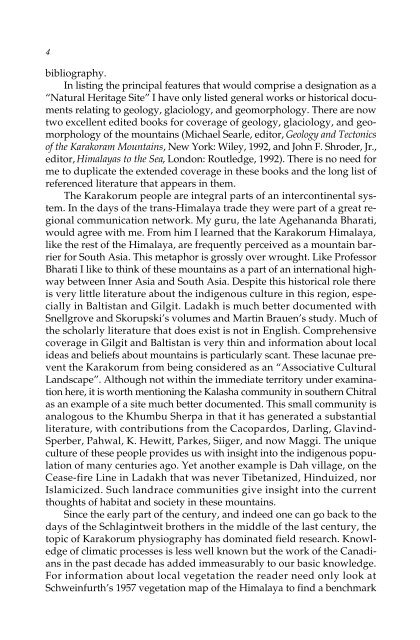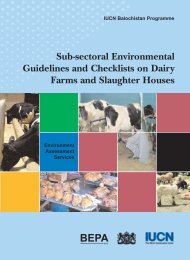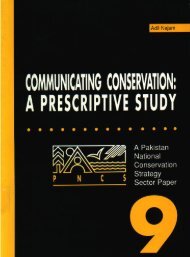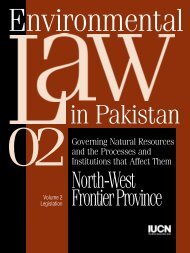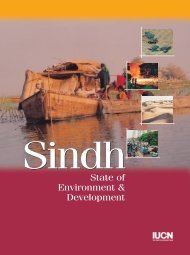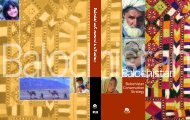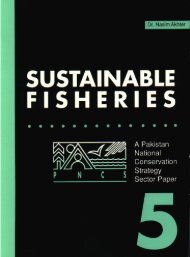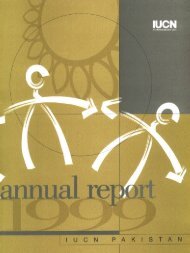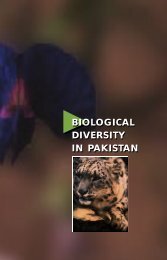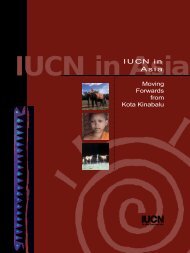Nigel JR Allan - IUCN - Pakistan
Nigel JR Allan - IUCN - Pakistan
Nigel JR Allan - IUCN - Pakistan
Create successful ePaper yourself
Turn your PDF publications into a flip-book with our unique Google optimized e-Paper software.
4<br />
bibliography.<br />
In listing the principal features that would comprise a designation as a<br />
“Natural Heritage Site” I have only listed general works or historical documents<br />
relating to geology, glaciology, and geomorphology. There are now<br />
two excellent edited books for coverage of geology, glaciology, and geomorphology<br />
of the mountains (Michael Searle, editor, Geology and Tectonics<br />
of the Karakoram Mountains, New York: Wiley, 1992, and John F. Shroder, Jr.,<br />
editor, Himalayas to the Sea, London: Routledge, 1992). There is no need for<br />
me to duplicate the extended coverage in these books and the long list of<br />
referenced literature that appears in them.<br />
The Karakorum people are integral parts of an intercontinental system.<br />
In the days of the trans-Himalaya trade they were part of a great regional<br />
communication network. My guru, the late Agehananda Bharati,<br />
would agree with me. From him I learned that the Karakorum Himalaya,<br />
like the rest of the Himalaya, are frequently perceived as a mountain barrier<br />
for South Asia. This metaphor is grossly over wrought. Like Professor<br />
Bharati I like to think of these mountains as a part of an international highway<br />
between Inner Asia and South Asia. Despite this historical role there<br />
is very little literature about the indigenous culture in this region, especially<br />
in Baltistan and Gilgit. Ladakh is much better documented with<br />
Snellgrove and Skorupski’s volumes and Martin Brauen’s study. Much of<br />
the scholarly literature that does exist is not in English. Comprehensive<br />
coverage in Gilgit and Baltistan is very thin and information about local<br />
ideas and beliefs about mountains is particularly scant. These lacunae prevent<br />
the Karakorum from being considered as an “Associative Cultural<br />
Landscape”. Although not within the immediate territory under examination<br />
here, it is worth mentioning the Kalasha community in southern Chitral<br />
as an example of a site much better documented. This small community is<br />
analogous to the Khumbu Sherpa in that it has generated a substantial<br />
literature, with contributions from the Cacopardos, Darling, Glavind-<br />
Sperber, Pahwal, K. Hewitt, Parkes, Siiger, and now Maggi. The unique<br />
culture of these people provides us with insight into the indigenous population<br />
of many centuries ago. Yet another example is Dah village, on the<br />
Cease-fire Line in Ladakh that was never Tibetanized, Hinduized, nor<br />
Islamicized. Such landrace communities give insight into the current<br />
thoughts of habitat and society in these mountains.<br />
Since the early part of the century, and indeed one can go back to the<br />
days of the Schlagintweit brothers in the middle of the last century, the<br />
topic of Karakorum physiography has dominated field research. Knowledge<br />
of climatic processes is less well known but the work of the Canadians<br />
in the past decade has added immeasurably to our basic knowledge.<br />
For information about local vegetation the reader need only look at<br />
Schweinfurth’s 1957 vegetation map of the Himalaya to find a benchmark


